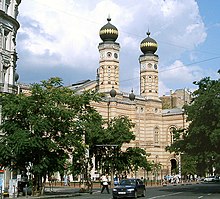Dohány Street Synagogue
| Dohány Street Synagogue Dohány utcai Zsinagóga (Hungarian) |
|
|---|---|

View of the synagogue from the Dohány street
|
|
| Basic information | |
| Location | Budapest, Hungary |
| Geographic coordinates | 47°29′45″N 19°03′39″E / 47.49583°N 19.06083°ECoordinates: 47°29′45″N 19°03′39″E / 47.49583°N 19.06083°E |
| Affiliation | Neolog Judaism |
| Year consecrated | 1859 |
| Status | Active |
| Website | dohany-zsinagoga |
| Architectural description | |
| Architect(s) | Ludwig Förster |
| Architectural type | Synagogue |
| Architectural style | Moorish Revival |
| Groundbreaking | 1854 |
| Completed | 1859 |
| Specifications | |
| Direction of façade | SWbS |
| Capacity | 2,964 |
| Length | 75 m (246 ft) |
| Width | 27 m (89 ft) |
| Width (nave) | 12 m (39 ft) |
| Height (max) | 43.6 m (143 ft) |
The Dohány Street Synagogue (Hungarian: Dohány utcai zsinagóga/nagy zsinagóga, Hebrew: בית הכנסת הגדול של בודפשט Bet ha-Knesset ha-Gadol shel Budapesht), also known as The Great Synagogue or Tabakgasse Synagogue, is a historical building in Erzsébetváros, the 7th district of Budapest, Hungary. It is the largest synagogue in Europe and the second largest in the world. It seats 3,000 people and is a centre of Neolog Judaism.
The synagogue was built between 1854 and 1859 in the Moorish Revival style, with the decoration based chiefly on Islamic models from North Africa and medieval Spain (the Alhambra). The synagogue's Viennese architect, Ludwig Förster, believed that no distinctively Jewish architecture could be identified, and thus chose "architectural forms that have been used by oriental ethnic groups that are related to the Israelite people, and in particular the Arabs". The interior design is partly by Frigyes Feszl.
The Dohány Street Synagogue complex consists of the Great Synagogue, the Heroes' Temple, the graveyard, the Memorial and the Jewish Museum, which was built on the site on which Theodor Herzl's house of birth stood. Dohány Street itself, a leafy street in the city center, carries strong Holocaust connotations as it constituted the border of the Budapest Ghetto.
Built in a residential area between 1854-1859 by the Jewish community of Pest according to the plans of Ludwig Förster, the monumental synagogue has a capacity of 2,964 seats (1,492 for men and 1,472 in the women's galleries) making it the largest in Europe and one of the largest working synagogues in the world (after the Beit Midrash of Ger in Jerusalem, the Belz Great Synagogue and Temple Emanu-el in New York City). The consecration of the synagogue took place on 6 September 1859.
...
Wikipedia
